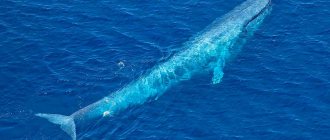How much does a blue whale weigh?
Females of these mammals weigh more (180,000 kg) than males (150,000 kg), and a baby that has just been born weighs approximately 2,700 kg. An adult hippopotamus in its prime weighs the same. The heart can weigh 450 kg, and it’s also interesting that the blue whale’s aorta is so large that an average person can easily climb through it.
Whale food
Although huge mammals pose a danger to many inhabitants, their diet is rather meager. Whalebone allows them to filter water, and a special fringe holds food in the animal’s mouth. The main food of giants:
- plankton;
- squid;
- fish.
Whales eat krill and small crustaceans. But he won’t eat fish on purpose. It becomes food only if it accidentally falls into the animal's mouth. If a mammal cannot find a large accumulation of plankton for a long time, it attacks schools of squid. At the same time, he has to filter tons of water.
When feeding, the whale spends a large amount of energy, so after feeding it rests for a long time. An adult giant eats 3-4 tons of live food per day. And he looks for food at a depth of 80-150 m.
Whaling
The demand for whale oil and baleen was so great that according to records, approximately 380,000 whales were caught and killed. The International Whaling Commission took the blue whale under protection only in 1966. Now their population has begun to grow, but there are still poachers who kill these animals. The remaining number of blue whales is proportional to 0.15% of the original number.
Appearance
The mammal has gray skin covered with spots. The head is darker, the sides and back are light, and the belly is yellowish. Because of this, the vomit was previously called the yellow-bellied. But if you look at a whale through sea water, it appears blue. The animal's skin is smooth, but in the throat and abdomen it gathers into folds. The mammal is home to many parasites; they settle on the surface of its body and in the whalebone.
The eyes of the vomit are small - only 10 cm in diameter, and in shape they resemble a horseshoe. The curved jaw protrudes forward, it protrudes about 20 cm. Whales are warm-blooded animals; a thick layer of fat allows them to maintain their temperature.
The respiratory organs are the powerful lungs. At one time, the animal is able to carry out almost complete air exchange. Thanks to this, the whale can stay underwater for up to 40 minutes. And when rising, the mammal releases a fountain of air, accompanied by a roar.
How do whales breathe underwater?
Blue whales don't actually have gills. This means they cannot extract oxygen from the water to breathe. The breathing hole is located at the top of the head. Whales use it when they swim on the surface. Unlike other species, the blue whale has two holes rather than one. They can hold their breath for up to 35 minutes underwater.
Origin of mammals
Whales descended from land-dwelling artiodactyls, so they are classified as mammals, not fish. Only as a result of long evolution did they acquire the same appearance as that of most sea inhabitants.
The first description of a vomit (“blue whale” in English) was made in 1694 by the scientist R. Sibbald. But he could not find a worthy name for it. Because of this, for a long time the whale was called Sibbald's minke whale. And only in 1758 C. Linnaeus named it Balaenoptera musculus (translated from Latin as “Muscular whale-wing”).
For a long time nothing was known about the mammal. Only towards the end of the 19th century did brief reports about the blue whale appear in reference books and encyclopedias. This type of animal includes three groups:
- dwarf;
- northern;
- southern.
They are practically the same in appearance, but there are significant differences in lifestyle, diet and population.
Speed
Blue whales often travel long distances, moving from polar regions where they feed in the summer and heading towards the equator as winter approaches. They can reach speeds of up to 50 kilometers per hour, but their normal speed is between 5 and 20 kilometers per hour. When feeding, females slow down to a speed of 5 kilometers per hour.
Habitat
In a short story or message about the blue whale, it is worth telling about its habitat. It used to be found in almost all oceans, but the number of animals has declined sharply in recent decades.
There are several areas left where you can find mammals:
- Antarctic and Arctic waters;
- Indian Ocean;
- coasts of Spain and Portugal.
In summer, whales live in the cold waters of the Arctic and Antarctic. And in winter they go towards the equator, although they do not swim to it. Dwarf species live exclusively in the Indian Ocean; they do not migrate. Whales change their habitat only because of their calves. Since their fat layer is too thin, it is dangerous for them to live in cold waters.
Although the mammals are most often found in the Southern Hemisphere, they can sometimes be seen off the coast of Spain and Portugal. On rare occasions, whales swim into waters near Russia.
Animals travel in herds, but they never intersect with another population. Even if their ranges coincide, different families do not communicate with each other.
Small brain
Compared to other organs and parts of the body, the whales' brain appears disproportionate. In size and weight, its part is 0.0007%. But this fact does not change the quality of brain activity in any way. Scientists believe that all cetaceans are very smart.
@janeb13 pixabay.com
Cetaceans send and receive 10-20 times more information than humans. Only the way of perception is different.
Urban legend. What is behind the game “Blue Whale” and the surge of interest in “suicidal publics”
This message (material) was created and (or) distributed by a foreign media outlet performing the functions of a foreign agent, and (or) a Russian legal entity performing the functions of a foreign agent.
We need your help. Please support Meduza.
Photo: Alexander Podgorchuk / Kommersant
In mid-February 2022, Russia again started talking about “death groups”—VKontakte communities where young people are given “tasks” that supposedly lead to suicide. The country's largest media outlets write about the "Blue Whale" game, during which a teenager must complete the same "tasks" (mainly related to causing physical harm to himself) for 50 days; The Investigative Committee found a trace of “suicidal publics” in several cases of attempted suicide. At the same time, researchers studying “death groups” are convinced that this phenomenon should be classified rather as an urban legend. Meduza tried to find out what the meaning of the Blue Whale game was.
At the beginning of February 2022, a heated discussion of the game, known to journalists as “Blue Whale” - under the hashtag #siniikit - began again on the Russian-language Internet. This is one of the hashtags that social media users (usually teenagers) post on their pages to get involved; there are others: #yavigre, #quiethome, #blue, #blue.
The hashtag is often accompanied by poetry; here are quite typical ones: “The blue house that stands on the waves











